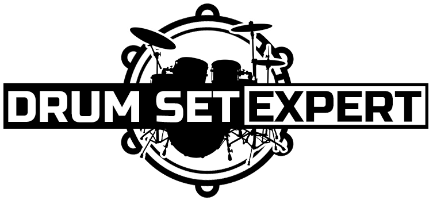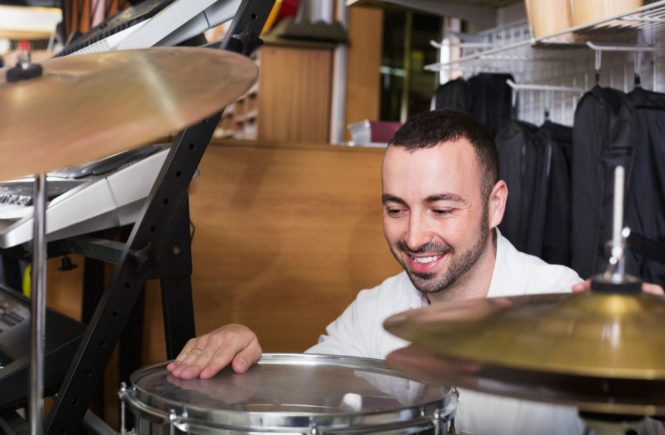When it comes to setting up a drum set the best approach is to make it as organized and as configured as possible according to your body size so that you can reach the instruments comfortably when you hit them while playing.
Fortunately, most of the kits used in setting up drum sets are standard in design so that they can accommodate drummers of any body size. The following are guidelines that will help anyone in setting up a drum set:
Prepare the kit
Gather first the needed parts of the drum set so that you can set them up easily in one area without going back and forth where you keep the kit. Aside from the cymbals and drums, one of the important tools that you should have beside you while setting up the drum set is the drum key.
It is an indispensable tool as it is used for tightening and loosening small bolts in the drum kit. The pieces you will likely need in setting up a drum set are the following:
- Bass, or kick drum with pedal
- Crash cymbal
- Hi-hat cymbal
- Snare drum
- Ride cymbal
- Toms and floor tom
- Throne, or simply a stool where you will sit
Look for an appropriate area where you will set up the drum set
Finding the right area for your drum set will determine how conveniently you can play the drum set. You will likely need a sufficient space where the instruments will not be too close to one another.
Aside from having an awkward position, compressing them will make it difficult for you to play harmonically as their sound may likely interfere with one another in unnatural movement, such as after you hit the cymbal the drum next to it is also banged since it is too close to each other. The rule of thumb for finding an appropriate area for setting the drum is by looking for a space where you can stretch like an eagle.
Take a maintenance check
Performing a maintenance check over the instruments is a precautionary measure so that that you will be sure that they are in good condition before using them. Otherwise you will have to suffer the inconvenience of disassembling them again.
Check the following possible issues before proceeding in setting up your drum set:
- Drum heads that are worn out
- Noisy kick drum pedals
- Rubber support feet that are already worn out
- Grime and dust accumulated on the instruments
Centering the bass drum
Proceed properly in setting the drum set because you will have to set up the bass drum first as it is the very first instrument where the position of other instruments will be based. Put the bass drum on the floor in a vertical manner where its logo is facing the audience.
The bass drum has two metal legs; make sure to properly fit them in to the two holes where they will serve as the stand for the bass drum. Before tightening the brackets for the leg make sure that you have adjusted the feet accordingly by making the base drum lean slightly forward so that they can support the drum’s weight, especially during play when it is banged by the foot pedal.
Bass drum legs are either with rubber feet or with spikes. Bass drum legs with rubber feet are often used because they don’t leave marks on the floor unlike with spikes than can leave marks and gouges on hard flooring.
Installing the Kick drum
Normally the kick drum is installed at the bass’s bottom edge and screwed with a bracket. The foot pedal’s bottom edge should be slipped under the bass drum’s bottom center, then tighten the screw of the upper part of the pedal to strengthen it.
For final checking, the pedal should be clamped on the bass drum’s bottom edge and cling firmly.
Placing the throne
The throne or the seat of the drummer is usually adjustable. It can be set up according to the height and convenience of the drummer using the lever or knob adjuster.
The best way of finding the appropriate height of the throne is by sitting on it while testing the kick drum. The most convenient position is the most ideal setting of the throne’s height.
Setting the snare drum
Snare drums normally have three short stands with rubberized feet to keep the drum stable during playing. It is also adjustable as it has horizontal arms that keep the snare in position.
In setting the stand, just spread the legs at the bottom to keep it erect and adjust the arm angles by using the top lift mechanism. The snare is securely connected to the stand’s arms at a horizontal angle although such an angle may be based on the preference of the drummer.
The height of the snare is adjusted through the telescoping central column. On the snare stand there is a main nut which is adjusted according to the desired height of the snare. Some drummers prefer the height of the snare in a way that it will not hit the legs during play.
Mounting the toms on the bass drum
Bass drums usually have metal brackets on the top where toms can be mounted in the same way of mounting the bass drum’s legs. Two separate holes can be seen on the top of a bass drum. Each of these holes is designed for the mounting pole where the toms are fixed.
However, some bass drums only have one hole. On this type two toms are connected to one central pole to accommodate the toms on the bass drum.
Setting the floor toms
Floor toms have metal legs that come with rubber feet and a “bend” which is small enough for offsetting the feet from the drum’s edges. First loosen the knobs located on the floor tom’s side then insert the legs with feet that are facing down.
Before tightening the nuts make sure that the drum is placed slightly above the feet and is well-secured. Test the drum by giving it some strikes and see if it will not move during playing.
Place the floor tom in front of and to the bass drum’s right for right handed set-up so that the right hand can comfortably hit it. The floor toms are usually adjusted parallel to the height of the snare drum.
Setting the cymbals
The hi-hat stand is the stand where the hi-hat cymbals are placed. It is a medium-height and straight stand with a pedal and three legs. When erecting the stand just spread its legs to secure a good base.
Hi-hat cymbals are either the top or bottom cymbal. The top cymbal usually bears the name of the manufacturer. When adjusting the cymbals place the bottom cymbal by sliding it above the hi-hat stand in a cupped position.
Next, loosen the hi-hat clutch bottom nut because this will hold the top cymbal to the stand. Then place the cymbal between the two felt pads located in the hi-hat clutch. Put back the nut on the bottom then secure the hi-hat clutch on the stand.
The cymbal is usually placed to the snare’s left side so that the right hand stick can beat it while the pedal is pressed using the left foot.

